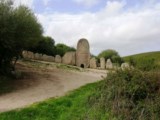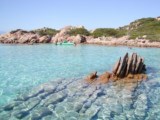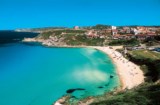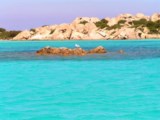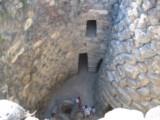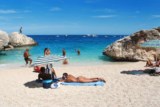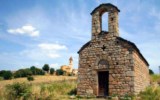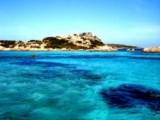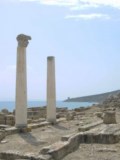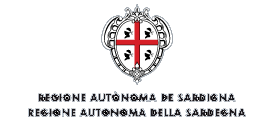
HOTEL ROOMS & ACCOMMODATIONS OFFERS IN SARDINIA SOUTH ITALY
STAY BY GEOGRAPHICAL DESTINATION IN COASTAL MOUNTAIN OR RURAL AREA
Wine & Food
Gennargentu Nat Park
Maddalena Nat Park
Nuraghe Discovered
Sardinia is the second largest island in the Mediterranean but also a mini-continent for the numerous varieties of human and natural environments which characterize it.
Seaside views in Sardinia are among the most marvellous in the world. Most beautiful little isles are interspersed around its coastline. The coasts are scraggy and rocky, surrounded by shallow sea and scattered with astonishing beaches of very fine sand and innumerable coves. Sardinia inspired D. H. Lawrence who dedicated to it, Sea and Sardinia, where he wrote: "Sardinia is left outside of time and history".
Lawrence's observation succeeds in defining a feeling which everyone who goes to Sardinia agrees to "the perception of being in a place where the striking beauty of nature, the emerald clear waters of the sea, the genuine and natural temperament of the people, the excellent typical cuisine, the millennial traditions and incomparable expressions of Sardinian culture, will be there forever."
The coasts are jagged and rocky, interspersed with marvelous beaches of very fine sand and countless inlets. The seaside landscapes, especially on the Costa Smeralda, are among the most beautiful in the world. Numerous small, enchanting islets are scattered in front of the coasts.
Food & Wine
Other Info

Traditional Sardinian cuisine evolved from the island's mountainous terrain and its pastoral and hunting traditions, using the food available in the interior: wild herbs, lamb, wild boar, honey, myrtle, olives. Pork, suckling pig, lamb, kid are specialities, and wild boar particularly during the November-January hunting season, all seasoned with wild rosemary and other mountain herbs.
A traditional first course is Zuppa Gallurese, not really a soup but layers of bread and cheese moistened with meat stock and baked in the oven till a golden crust forms on top – a dish for hearty peasant appetites...
Other typical Sardinian dishes include Gnocchetti Sardi, Porcetto al mirto (pork with Mirto), Capretto con patate (kid with potatoes), Pesce alla Crosta di Sale (fish in salt) and Seadas (deep fried honey pastries). On or near the coast local fish, lobsters and shellfish appear on most menus, caught out of ports such as Palau or Olbia.
Saffron, zafferano, is grown on the island and used in traditional dishes, often savoury, such as malloreddus pasta.
Sardinia offers a variety of typical wines, going from the Moscatos to the Vernaccia of Oristano and Vermentino of Sardegna
The most popular of wines in Sardinia is the Cannonau, made from Cannonau vines. (At least 90 % of this grapes has to be used to be certified as original Cannonau).
The wine has to be one year in Oak barrels before coming to the tables.
The alcoholic content of the Cannonau is minimum 13 ° and some types of this wine can have 15° of alcoholic content (Dry Cannonau), and should be served at a temperature of 18-20°. Cannonau is a very "strong wine" so it should be used with elaborate red meet and some types of cheese.
The Wine Museum (Museo del Vino) in Berchidda shows the history of viticulture on the island, tracing its production through various ages and influences including the Phoenicians, Carthagians and Romans, with displays of historic winemaking equipment and a section dedicated to cork (sughero), still a major industry here on the island.
The museum is housed in a purpose-built modern structure on the hillside above the town of Berchidda, and has stunning views out across the plains, vineyards and to the mountains beyond. Tours can be arranged, including guided tastings of a range of wines.
Mirto made from the myrtle berries which ripen in winter, this is usually a dark red, sweet liqueur, although white mirto can also be found. Good-quality mirto is fragrant and has hints of the herbs of the macchia where the myrtle bushes grow. Limoncello is also made on the island. Again, good quality limoncello is worth finding; fragrant and full of intense lemoniness.
WHERE TO EAT - WHERE TO HAVE FUN - SPONSORS |
| |
|
| |
|
YOUR ADVERTISEMENT BANNER HERE |
History
Sardinia is one of the most ancient lands in Europe, visited during the Palaeolithic period though inhabited permanently by humans only much later, in the Neolithic age, around 6,000 BC.
The first humans to settle in Gallura and northern Sardinia probably came from the Italian mainland and, in particular, from Etruria. Those who populated the central region of the island around the salt lakes of Cabras and S. Giusta may have arrived from the Iberian Peninsula by way of the Balearic Islands. Those who founded their settlements around the Gulf of Cagliari were made up of several peoples.
Evidence of trade with other Aegean centres is present in the period 1600 BC onwards; for example fine ceramic products of Cydonia have been recovered in Sardinia. As time passed, the Sardinian peoples became united in language and customs, yet remained divided politically into various smaller tribal states. Sometimes they banded together, while at others they were at war with one another. Tribes lived in villages made up of round thatched stone huts, similar to those of present-day shepherds.
From about 1500 BC onwards, the villages were built at the foot of truncated cone fortresses (often reinforced and enlarged with embattled towers) called nuraghi (plural of nuraghe).
The boundaries of tribal territories were guarded by smaller lookout nuraghi erected on strategic hills commanding a view of the enemy. Today some 7,000 nuraghi dot the Sardinian landscape.
|



